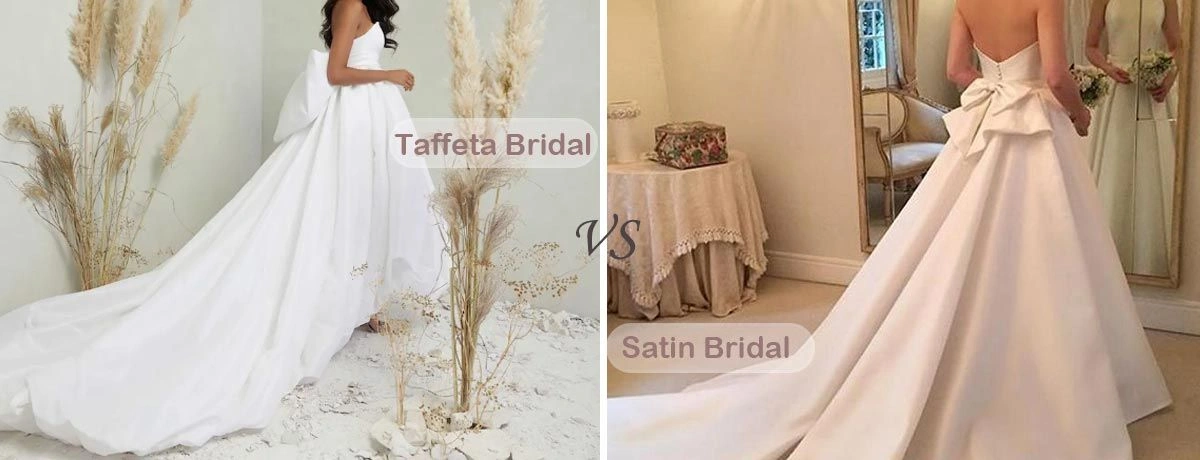Taffeta Fabric vs Satin in a Wedding Dress

Introduction
In the world of bridal, fabric is everything. The right fabric can turn a wedding dress into a masterpiece, accentuate the bride’s style and make it unforgettable. The choice of fabric significantly influences the design and style of bridal gowns, with materials like satin and taffeta shaping their structure and appearance. This post will break down the differences between the two to help wedding dress makers, bridal designers and manufacturers make informed decisions.
What is Satin and Taffeta Fabric
Satin
Satin has a smooth, shiny surface and feels luxurious. It is woven in a way that produces a soft, shiny front and a dull back. Satin is versatile and often used in wedding dresses for its flowy drape and shiny look. Comparing satin to taffeta, satin is shinier and limper, making it suitable for gowns that cling to the body, whereas taffeta is stiffer and more matte, giving gowns more structure.
Taffeta
Taffeta is a crisp, smooth fabric with a structured finish and a bit of sheen. It’s usually woven from silk or synthetic fibers, often featuring a heavier weave that enhances its rigidity. As a stiffer fabric, taffeta provides more structure to bridal gowns, making it ideal for creating volume and holding shape.
Texture and Sheen
Satin and taffeta are worlds apart in texture and sheen. Satin has a silky, fluid texture that drapes with movement, perfect for flowing silhouettes. Taffeta is stiffer and more structured, great for dresses that need shape and volume. Satin has a high gloss finish, taffeta has a more subtle sheen. For designers, understanding these differences will help you choose the right fabric for the look you want. When deciding between a satin dress and a 'taffeta one,' consider the structural differences and how they impact the overall elegance and sophistication.
Durability and Comfort
When it comes to durability and comfort, both fabrics have their own quirks. Satin, though luxurious, can snag and pull if not handled carefully. It’s more comfortable in cooler climates as it doesn’t breathe as well as other fabrics. Taffeta is durable and can take more wear, but can be uncomfortable if worn for long periods as it’s stiff and doesn’t breathe well. Designers should consider the location and duration of the event when choosing between these fabrics.
Breathability and Seasonality
When it comes to breathability, taffeta fabric is not the most forgiving. Its stiffer, less porous nature makes it less suitable for warm weather or outdoor events. However, the crisp, smooth texture and luxurious feel of taffeta make it a popular choice for formal wear and special occasions. If you’re considering taffeta for a wedding dress or evening gown, think about the season and venue. A taffeta wedding dress is ideal for a winter or fall wedding, providing warmth and structure. For a summer wedding, a lighter, more breathable fabric might be a better choice to ensure comfort throughout the day.
Cost and Availability
The cost of satin and taffeta varies greatly depending on quality and fiber content. Silk satin and taffeta are premium options and more expensive, polyester versions are more budget friendly. Satin is more widely available as it’s used in many types of garments beyond bridal. Taffeta is more niche but still available if you look for it.
Luxury Fabric Options
For those seeking the pinnacle of luxury in wedding dresses and formal gowns, silk taffeta stands out as a top choice. This exquisite fabric is renowned for its smooth, lustrous texture and elegant appearance. Silk taffeta is often the go-to for ball gowns and formal styles, thanks to its ability to drape beautifully and create a dramatic, eye-catching presence. The luxurious feel of silk taffeta adds an extra layer of sophistication to any dress, making it a favorite among designers aiming for high-end, glamorous looks.
Styling and Design Considerations
The choice between satin and taffeta will affect the overall look and feel of the wedding dress. Satin is perfect for sleek, modern designs with a touch of romance, taffeta is for traditional and dramatic styles with structured silhouettes. Designers can use the flow of satin for dresses that skim the body, the rigidity of taffeta for voluminous skirts and architectural details.
Considerations for Ball Gowns and Formal Styles
When selecting a fabric for a ball gown or formal style, it’s crucial to consider the event’s theme and formality. Taffeta fabric, with its crisp, smooth texture and luxurious feel, is a popular choice for formal wear. Its structured nature makes it perfect for creating voluminous skirts and dramatic silhouettes. However, if the design leans towards a more casual or whimsical style, taffeta might not be the best fit. Satin, with its soft, smooth texture and elegant appearance, is also a popular choice for formal events. It offers a different kind of elegance, ideal for sleek, modern designs that require a fluid drape.
Conclusion
In short, satin and taffeta are two different fabrics for different designs. Satin is fluid and glossy, taffeta is structured and refined. Designers should try both out and see what works for their design. Share your experiences and comments below!
By knowing the differences between satin and taffeta, designers can serve their clients better and create dresses that make each bride feel beautiful and unique.
